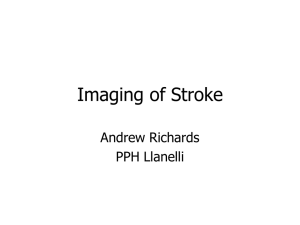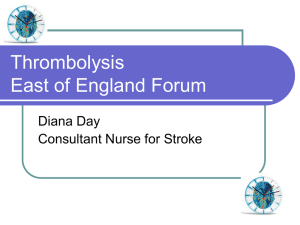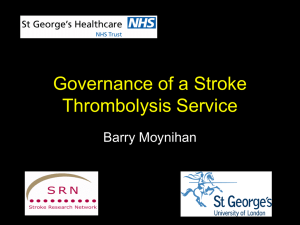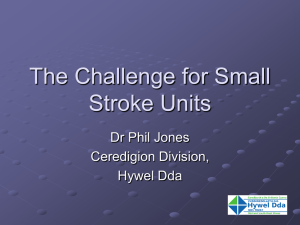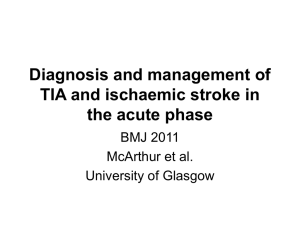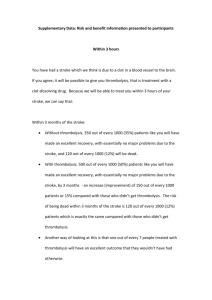Indications for thrombolysis
advertisement
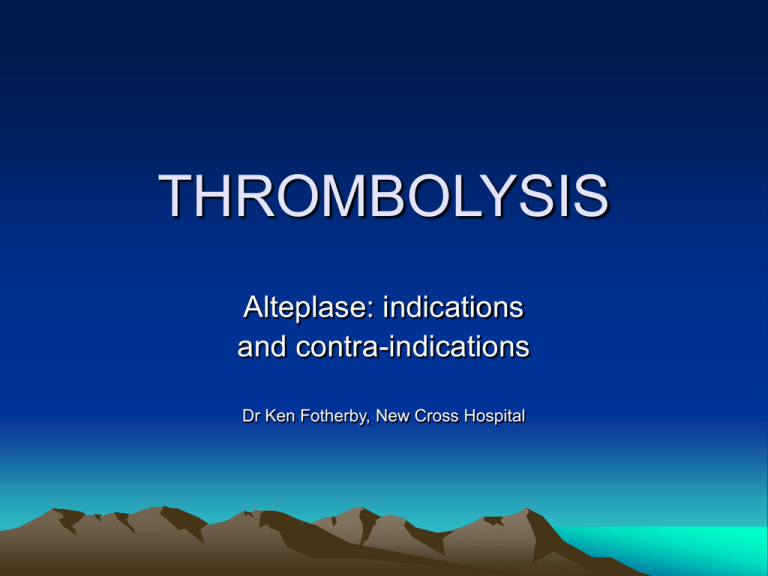
THROMBOLYSIS Alteplase: indications and contra-indications Dr Ken Fotherby, New Cross Hospital Thrombolysis: Yes? No? • Ischaemic stroke (not bleed or mimic) • Within 3h onset • No ^^risk bleeding (BP>185/110 • • • warfarin/heparin recent stroke recent surgery) • Minor/rapidly improving stroke New Cross experience • DGH serving ~250,000 pop • Thrombolysis service 9am-5pm:May 07 • Assessed 21 patients12 thrombolysed ie. ~1/wk assessed ~1/fortnight treated Alteplase for ischaemic stroke • N.N.T. to prevent death/severe dependency? Alteplase for ischaemic stroke • N.N.T. to prevent death/severe dependency? 6 (NINDS) 9 (NICE ) and 3 to reduce dependency (NINDS) Alteplase for ischaemic stroke • N.N.H. (ie cause symptomatic intra-cranial haemorrhage)? Alteplase for ischaemic stroke • N.N.H. (ie cause symptomatic intra-cranial haemorrhage)? 17 6% NINDS 4-7% SITS-MOST,CASES,STARS (16% in Cleveland) ( ~1% for MI) Thrombolysis: Yes? No? • Ischaemic stroke (not bleed or mimic) • Within 3h onset • No ^^risk bleeding (BP>185/110 • • • warfarin/heparin recent stroke recent surgery) • Minor/rapidly improving stroke Thrombolysis: ?is ischaemic stroke - Clinical diagnosis but CT scan to exclude bleed - Exclude stroke mimics: epileptic fit hypoglycaemia Thrombolysis: ?within 3 hours • Clear time onset (or when last well) • Usually need eye-witness paramedics report “Time is Brain” Thrombolysis: ?too risky ^ risk intra-cranial bleeding: - BP>185/110 (reassure,?labetalol or GTN patch) - Abnormal clotting (warfarin,heparin,haemodialysis) (INR 1.4 or less OK) - ?Massive infarct (NIHSS>25) ?Old age (>80yr) Prior stroke within 3months (but TIA OK) Any i/c bleed in past major surgery, G-I bleed, haematuria past 3 weeks Thrombolysis: ?too risky Prognosis “too good”: - Small stroke (NIHSS 4 or less) but ? lone dysphasia Thrombolysis: Yes? No? • Ischaemic stroke (not bleed or mimic) • Within 3h onset • No ^^risk bleeding (BP>185/110 • • • warfarin/heparin recent stroke recent surgery) • Minor/rapidly improving stroke Putting it all together! spouse paramedic nurse BP + BM arrange CTscan clinical assessment venflon bloods porter arrange bed DOCTOR-PATIENT relatives assent/consent NIHSScore weight/dose BP (again) read CT scan start drug Thrombolysis: how often? • Best = 20% of acute stroke patients (and 2006 NSentinelStroke Audit:39% admitted <2h) • strokes/year /250,000 pop = 530 = c400 admitted (excl MAU discharges) = c250 “ “ “ “ “ and aged <80yrs - 40% of 400 = 160 assessments/y or 3/wk 20% 400 = 80 thrombolyses/y or 1-2/wk Thrombolysis: an effective & safe service? • Written protocols within an (established) pathway. ( licence & NICE:”only by a physician trained and experienced in the management of acute stroke and in a centre with appropriate facilities”) Pathways and Protocols for thrombolysis paramedics I A&E I CT scanning I Stroke Unit (9am-5pm) Pathways and Protocols for thrombolysis paramedics I A&E I CT scanning I Stroke Unit (9am-5pm) G.P.s/community I paramedics I A&E I CT scanning I Stroke Unit (8am-8pm+)
